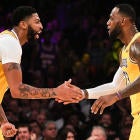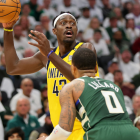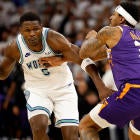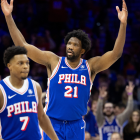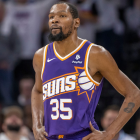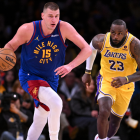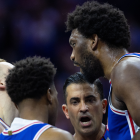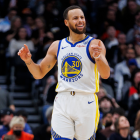Trying to understand the NBA salary cap can seem more complicated than sending an astronaut to Mars. That's why every team employs multiple "capologists," tasked with finding the best and most efficient ways to spend the organization's resources. For some teams, that means grabbing a couple of superstars and making the most of their minimum salaries and mid-level exception. For others, it means making sure they avoid the luxury tax by staying just under the line.
This leads to different roster constructions throughout the league, and this visualization from Chicago-based ticket marketplace Vivid Seats demonstrates that phenomenon. Each team's payroll is represented by circles with a player's name in the middle -- the bigger the circle, the larger the salary. You can also look ahead to future seasons to see who's on the books moving forward. Take a stroll through the interactive graphic below (you can click on individual teams for a closer look), and there are a few things that will stand out.
Dynamic Duos
Last summer the NBA continued its transition from the "Big Three" era to superstar duos, and the salaries for most top teams reflect that. Four of the five teams with the league's best records (Bucks, Lakers, Clippers and Celtics) have the majority of their salary going to two players. The Raptors are the only team in the top five paying over $20 million to three players -- Kyle Lowry, Marc Gasol and Serge Ibaka.
Sharing the wealth
The best teams in the league are top-heavy when it comes to salary, but there is a large group of teams staying competitive with a much more balanced payroll. The Miami Heat, owners of the eighth-best record in the NBA, have six players making $10 million or more, while the Nuggets, Pacers and Thunder have five players making at least $10 million. The most egalitarian team to have success this season, however, is the Memphis Grizzlies. They have 10 players making between $6.9 million and the team's top salary of $16.2 million (Gorgui Dieng), a rarity for an NBA playoff team.
Bad money = Bad teams
This isn't exactly a revelation but it's interesting to see it visualized: Bad teams spend a lot of money on bad or injured players. The Suns are paying Tyler Johnson roughly $19 million and have already waived him. The Hornets are paying over $25 million for Nicolas Batum's 3.6 points per game. The Pistons' top earner, Blake Griffin, at $34 million, played only 18 games at less than full strength before being shut down for the season. The Warriors, the league's worst team, are paying over $72 million to Stephen Curry and Klay Thompson, who have combined to play five games this season. John Wall, the Wizards' highest-paid player at $38 million, hasn't played since December of 2018.
Large money being allocated to an injured or below average player isn't always a mistake, though. Some non-playoff teams choose to utilize their salary cap space to take on bad contracts in exchange for assets, and you also see those in the graphic. The Hawks paying Chandler Parsons $25 million and the Timberwolves taking on the hefty contracts of Allen Crabbe and Evan Turner are examples of how teams can use this strategy.













